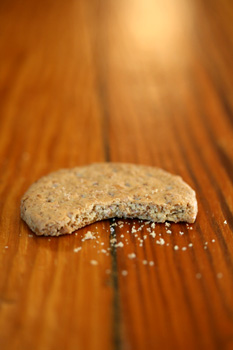 Whoops, I just dropped food on my kitchen floor. The floor looked clean since we don’t wear shoes in the house, but is it safe to still eat it? Some people say yes. My inner yuck meter went off, so I tucked it into the trash. I never believed in the five second rule anyhow – a rule that allows people to feel good after eating something that may or may not have bacteria on it depending on how long it rested on a dirty surface.
Whoops, I just dropped food on my kitchen floor. The floor looked clean since we don’t wear shoes in the house, but is it safe to still eat it? Some people say yes. My inner yuck meter went off, so I tucked it into the trash. I never believed in the five second rule anyhow – a rule that allows people to feel good after eating something that may or may not have bacteria on it depending on how long it rested on a dirty surface.
“So when food picks up bacteria, how does it work exactly?” I asked my husband, a PhD in organic chemistry, that discusses my countless questions and arguments regarding health practices and food.
“It’s about surface area and how much of the food makes contact. Take a piece of pepperoni,” he began. No wonder he chose pepperoni – greasy, spicy, and salty – one of his favorite foods. “You see, if the pepperoni falls on the carpet it makes less contact with the bacteria that might be resting in the rug. If it falls on the hardwood floor or linoleum, then there is more surface area, more contact for bacteria to attach to the meat. Time has nothing to do with it – once contact is made, you’ve got the coodies!”
Ah, so speaking of germs and bacteria – what is the best way to be sure your food isn’t loaded with harmful bacteria? Here’s a quick top five list to keep food safe while you’re cooking.
1. Refrigerate it. Don’t leave raw meats, dairy, or cheese out on the counter. Bacteria multiply quickly at warm temperatures while refrigeration and freezing helps to slow bacterial growth and decay. Placing fresh groceries immediately in the fridge also scores major points with the your significant other who does most of the cooking.
2. Scrub up. Yes, always wash your hands before cooking – even if you were just typing an e-mail and your hands don’t seem dirty, believe me they are! I even wash my hands in between if I answer the door.
3. Wash it. I rinse all veggies and even the rind of citrus fruit if I’m using the peel. I rinse chicken and most of my shrimp and pat them dry with a paper towel. When in doubt, clean it. Use a separate cutting board for meat, fish, poultry, and don’t place or cut raw veggies on the same board. If you only have one cutting board – never fear, bleach is here. Place your board in the sink and pour a little bleach on it – watch your eyes and don’t get it on your hands. Pour boiling hot water over it to kills germs.
4. Cook it. To kill most bacteria in meat, like beef and pork, you should get to 160° F. Use a food thermometer to check. Make sure the food thermometer goes straight into the meat, but does not touch the pan at all. When it comes to ground meat, you should be especially careful. When meat is ground, there is a chance that any bacteria on the outside of the meat or from another infected piece can be mixed about from the grinder. Ever notice that ground meat spoils faster? Grinding exposing more of the meat’s surface to oxygen that reacts with meat cells, causing spoilage. What about poultry? Cook chicken breast to an internal temp of 170° F and a whole bird to 180° F.
5. The Nose Knows. Yes – if it isn’t an aged cheese and it smells bad – it probably is! That means if a familiar food smells strange, sour, or sulfurous – the so called “rotten egg” smell, don’t take a chance by eating it. The nose isn’t the perfect test of freshness, however, if you notice a strong or unpleasant odor it could be a sign that bacteria growing in food are producing gases that give food that strange, unappealing smell.


 Are you ready to look better, feel more energized, and get back that youthful feeling you remember having as a kid? I can help you on a journey that will change the way you eat — for good. My
Are you ready to look better, feel more energized, and get back that youthful feeling you remember having as a kid? I can help you on a journey that will change the way you eat — for good. My 




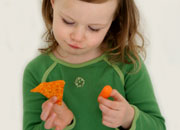
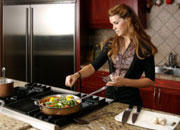



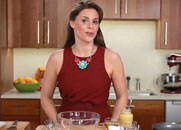

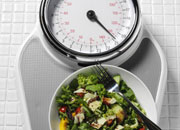


 As a healthy cooking expert, health coach and TV host,
As a healthy cooking expert, health coach and TV host, 

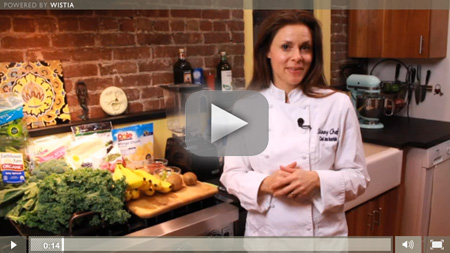

I seem to be seeing articles about food safety more and more lately. And when I see the lists of everything in a kitchen that sound be refrigerated (from nuts, to flours, to oils, etc.) I’m beginning to think that kitchens are made all wrong. The cabinets should all be refrigerated! 😉
I have a great set of flexible cutting boards, each with a different picture in the middle for fish, chicken, beef, and veggies. Makes it really easy to avoid the cross-contamination.
“Should be refrigerated” not “sound be refrigerated”.
What’s up with my typing?!
Yes, food safety seems to be featured quite a bit lately – just like this debate over MRSA in schools. I feel that somehow, people have lost touch with what’s safe and what’s not. Use some common sense!
One of my wife’s pet peeves is when I leave cooked food out on the counter – over night. From a food safety perspective, I like to remind her that while bacteria grow fairly quickly, it probably takes 12-16 hours for it to reach a critical point at which I wouldn’t eat it any more.
As the saying goes…when in doubt…throw it out!
Jake, 12-16 hours!!!! You must be crazy! 🙂
What gives me the creeps are kitchen sponges. I use a small kitchen cloth instead. Every night it gets thrown in the laundry along with the dish towel.
I agree with you Kathy 🙂
Per the kitchen sponge- I throw my in the dishwasher before they get too gross. The bleach in the dishwashing detergent kills the bacteria and the smell. When they get too smelly, I toss em!
im doing my science proect essay thing on this!! haha great info! thanks =]